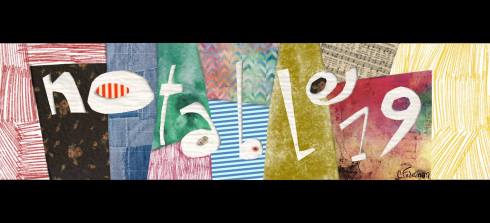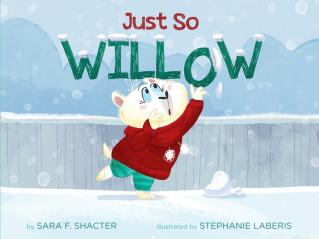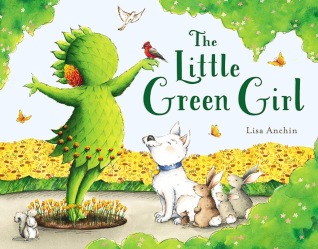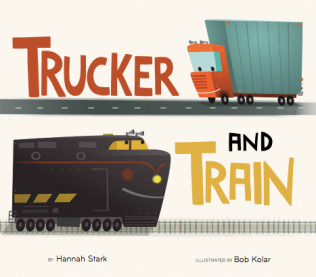When my debut THE MONSTORE arrived in 2013, there was one kidlit debut group, but it was primarily for YA and MG releases. But I asked if I could be involved because there was no “debut PB” blog. There were a few of us brave PB authors who charmed our way in. But now a debut picture book group is an ACTUAL THING! Hot-diggity-dachshund!

So today I would like to introduce you to THE NOTABLE19s! All these delicious titles will be releasing this year from new talents…
The Notable19s is a baker’s dozen of authors and illustrators who are debuting with their first-ever book, first author-illustrator book, or first book with a medium-to-large publisher in 2019. They want to share some writing or illustrating wisdom that they’ve learned on their journey to being published.
(Click on an author’s name to be transported to their website.)

When Stephanie V.W. Lucianovic wrote THE END OF SOMETHING WONDERFUL (Sterling), she thought she had an idea of what the illustrations would look like on every page, particularly the last one. But then George Ermos brought his amazing vision to the story and captured all that was darkly funny and sweet about the book. The last page of the book is both so perfect and something Stephanie never would have thought up herself. When you’re a text-only author, remember that the book is not just yours anymore and be open to the magic that comes from collaboration.

Teresa Robeson feels that being part of a larger creative community is integral to her publishing success. She recommends: joining SCBWI and attending events both regionally and in other chapters; participating in challenges like 12×12 (where she connected with her first agent), Storystorm, and NaPiBoWriWee; applying for opportunities like We Need Diverse Books; and being in one or more critique groups. Winning the WNDB mentorship with Jane Yolen led to a polished manuscript that became her debut picture book, QUEEN OF PHYSICS (illustrated by Rebecca Huang; Sterling).

Marcie Flinchum Atkins, author of WAIT, REST, PAUSE: DORMANCY IN NATURE (Millbrook Press, 2019), thinks you shouldn’t let your busy life hold you back from writing. Since her kids were toddlers, she’s been carrying a “writing bag” around stuffed with manuscripts in different stages, craft books, and research articles. This enables her to work on the go–in the pick up line at her kids’ sports practices, in the orthodontist’s waiting room, or in the ten-minute break between conference sessions.

Cathy Ballou Mealey, author of WHEN A TREE GROWS (illustrated by Kasia Nowowiejska; Sterling) suggests pasting your PB draft into a word cloud generator like WordItOut or Wordle to visually gauge the frequency of words in your text. A word cloud can help you find terms to cut or replace with stronger choices.

Cassandra Federman is the author-illustrator of THIS IS A SEA COW (Albert Whitman, 2019), in which a child writes a school report about sea cows and the subject is not happy with her portrayal. Sea Cow—or Manatee, as she prefers to be called—comes to life on the pages of the report and decides to defend herself with her own fascinating facts about manatees. Cassandra’s advice is to have honest, respectful conversations with your editors and art directors. Don’t be afraid! Discussing intentions, what works, what doesn’t, and why, will always lead to improvement.

In Sara F. Shacter’s picture book, JUST SO WILLOW, a type-A polar bear learns to let go. “Ironically, Willow helped me do the same! Early versions of my manuscript received the same comment from multiple editors: the end fell flat. I tweaked to no avail. Then editor Brett Duquette had the insight that led to my ‘ah-ha’ moment: the first three lines were bigger and funnier than the rest of the story. So I deleted everything but those compelling first lines and began anew. Success! Moral: experimentation is freeing. You can always go back to the original version.”

Lisa Anchin’s debut author-illustrated picture book, THE LITTLE GREEN GIRL (Dial), is about a persistent and curious little plant. Lisa, like the Little Green Girl, has learned that persistence is key in publishing. Her book took three years and thirteen drafts before it found a home at Dial, and it will be almost exactly five years from the very first sketch to publication. Don’t get discouraged if a project feels like it’s taking too long. Stick with it, and keep revising until it’s the best it can possibly be.

Richard Ho is the author of RED ROVER: CURIOSITY ON MARS, illustrated by Katherine Roy and published by Roaring Brook Press/Macmillan (October 29). In choosing a planet (take a bow, Mars!) as the narrator of a story about the Curiosity rover, Richard wanted to explore how far outside-the-box he could venture when it comes to matters of POV and story structure. As it turns out, Mars’ voice perfectly mirrored the wide-eyed innocence and wonder of a child observing Curiosity’s epic journey across a vast red landscape.

BRAVE MOLLY (Chronicle), by Brooke Boynton-Hughes, is a nearly wordless picture book that tells the story of a girl who has to overcome her fears in order to find her own voice and make a new friend. Molly’s story was born of Brooke’s frustration with her own shyness, social anxiety, and self-doubt. Telling our personal stories can feel vulnerable, but there is strength in sharing our own experiences. Be brave, like Molly, and tell the story that only you can tell.

Jessica Lanan is the author and illustrator of THE FISHERMAN AND THE WHALE and illustrator of over five other books. She finds it important to develop a habit of artistic exercise, regularly attending figure drawing groups, drawing and painting from life as often as possible, and keeping a sketchbook on hand at all times. Technical ability opens doors; the more artistic skill you can develop, the more options you will have to visually tell your story.

Shauna LaVoy Reynolds, author of POETREE (illustrated by Shahrzad Maydani; Dial), tells kids that passionate readers make the best writers. It’s true for adults, too! If you write picture books, take the time every week or so to raid your local library’s new releases. Bring home and read a stack of books, taking note of what works (and what doesn’t.) This will help get your brain into picture book voice mode, keep you aware of market trends, and of course satisfy your story-loving inner child.

Hannah Stark, author of TRUCKER AND TRAIN (illustrated by Bob Kolar; Clarion/HMH), considers herself a student of picture books more than a writer of them. Ann Whitford Paul’s book WRITING PICTURE BOOKS recommends typing up the text of recent picture books you love and those you thought were dreadful. With illustrations removed you can better study what works and what does not in the text. As a writer this has helped me learn so much about pacing, page turns, word count
and craft.

James Serafino, author-illustrator of THIS LITTLE PIGGY (Philomel) says, “The best advice I can think of for any writer is to work on your whole story. Don’t just focus on the beginning or your favorite part. I’ve spent days on writing the perfect opening line only to get to the end of the story and realize it wasn’t where the story should begin at all. Whenever you sit down to write go through the whole story arc from start to finish, every time. Don’t get stuck on small details until later when you can enjoy writing them into a story that works.”
To visit ALL of these fabulous authors and illustrators, visit Notable19.weebly.com and subscribe to be alerted when each title is available! Also follow along on Twitter @notable19s.















76 comments
Comments feed for this article
April 30, 2019 at 8:16 am
Mary Wagley Copp
I am so excited for these friends. (I was in the group until my pub date was moved to 2020.) They are wonderfully supportive folks and their books look amazing. I can’t wait to read them ALL! Thanks, Tara for sharing their good news.
April 30, 2019 at 11:16 am
Teresa Robeson
We have missed you, Mary! But I’m sure your new group is just as wonderful!
April 30, 2019 at 8:50 am
Laurel Ranveig Abell
These are all so WONDERFUL!!!!!!! Can’t wait to read them! Thank you for sharing such awesome news! xo
April 30, 2019 at 11:17 am
Teresa Robeson
Thank you, Laurel!
April 30, 2019 at 9:29 am
tinamcho
Awesome advice. Congrats authors!
April 30, 2019 at 11:18 am
Teresa Robeson
Thank you, Tina!
April 30, 2019 at 9:52 am
Carole Calladine
Thanks for sharing and congrats to all the debut authors.
April 30, 2019 at 11:18 am
Teresa Robeson
Thank you, Carole!
April 30, 2019 at 9:53 am
Author A. R. Curry
There’s some goooood looking books on that list!
April 30, 2019 at 11:19 am
Teresa Robeson
I think so, too, but I’m biased…LOL! 😉
April 30, 2019 at 9:56 am
Suzanne Lewis
Thanks for sharing this important don’t-give-up-on-your-story wisdom. Always important; always welcome. Congratulations all on these wonderful debut picture books!
April 30, 2019 at 11:20 am
Teresa Robeson
Thanks, Suzanne!
April 30, 2019 at 10:02 am
Claire W Bobrow
I am very excited for all the books on this list, and for their authors and illustrators. But I’m ESPECIALLY excited for my critique partner, Stephanie Lucianovic, and her debut, The End of Something Wonderful! And kudos to her co-creator, George Ermos. He made magic with his fabulous illustrations!
April 30, 2019 at 11:21 am
Teresa Robeson
Stephanie is as brilliant as she is lovely! You’re so lucky she is your CP. Her interview at the Notable19s blog comes out tomorrow; be sure to come check it out!
April 30, 2019 at 12:32 pm
Claire W Bobrow
I will, Teresa. Thank you! I’m super-excited for your book, too!!
April 30, 2019 at 10:03 am
debobrienbookscom
I loved the point about working on your entire story, not just your favorite parts. I think we all get sidelined on what we think will be a fun story and forget to step back and look at it with a critical eye. I know I’m guilty of that.
April 30, 2019 at 11:23 am
Teresa Robeson
I agree!
April 30, 2019 at 10:04 am
Angie
What a lovely line-up! Congratulations to everyone! Can’t wait to read each book.
April 30, 2019 at 11:23 am
Teresa Robeson
Thank you, Angie!
April 30, 2019 at 10:11 am
David McMullin
An amazing group of writers and books. Great advise form all of them.
April 30, 2019 at 11:24 am
Teresa Robeson
Thank you, David!
April 30, 2019 at 10:18 am
Sylvia Grech
Thanks for sharing!
April 30, 2019 at 11:26 am
Teresa Robeson
Thank for reading, Sylvia!
April 30, 2019 at 10:47 am
tiffanydickinson
Tara, these all look wonderful. Thanks for sharing! Congratulations to all the authors!
April 30, 2019 at 11:27 am
Teresa Robeson
Thank you, Tiffany!
April 30, 2019 at 10:53 am
Melanie Ellsworth
Wonderful tips! I’ve already read a few of these terrific books! Congratulations on your debuts.
April 30, 2019 at 11:39 am
Teresa Robeson
Thank you, Melanie!
April 30, 2019 at 10:57 am
Gabi Snyder
Can’t wait to get my hands on these lovely books. Congrats to all!
April 30, 2019 at 11:39 am
Teresa Robeson
Thank you, Gabi!
April 30, 2019 at 11:13 am
Nanette Heffernan
Excellent advice for every children’s author out there, from board book to young adult. Thanks!
April 30, 2019 at 11:40 am
Teresa Robeson
Thank you, Nanette!
April 30, 2019 at 11:16 am
Teresa Robeson
Tara, thank you SOOOO much for featuring my debut group Notable19s! I am so lucky to be among these wonderful folks. I know sometimes groups, because they bring together people from such varied backgrounds, can have some tension and drama, but I have to say that there is NONE of that in this group. We are all laid back and reasonable people and I feel like I have made some life-long friends here.
April 30, 2019 at 1:52 pm
Cathy Ballou Mealey
So true! And mostly because Teresa is the glue that holds us together, the engine that pulls us forward, and the cheerleader that keeps our spirits high. She’s too modest to say it (or even know it) herself, so I will! Thank you Teresa!
May 1, 2019 at 4:52 pm
Teresa Robeson
You are too sweet, Cathy! ❤ A great friend and a great liar…LOL! I can't even keep my own life together, let alone a group. I need a personal assistant! 😉
May 1, 2019 at 7:40 pm
Cathy Ballou Mealey
I will do it! You pay in cookies? Soap? Knitwear? ♥️ I am all in!
April 30, 2019 at 11:23 am
Danielle Dufayet
These books look amazing -what a wonderful bunch! Power to the groups!
April 30, 2019 at 11:40 am
Teresa Robeson
Aww, thanks, Danielle! Power to debut groups, indeed!
April 30, 2019 at 11:30 am
Stephanie V.W. Lucianovic
“laid back” LOL, Teresa! I’m a bundle of impatience and anxiety but I’m glad i seem to be hiding it well!
April 30, 2019 at 1:19 pm
Teresa Robeson
I can relate to impatience and anxiety…but at least you have cats to help calm you down when need be! 😀 That must be helping with the hiding.
April 30, 2019 at 12:29 pm
chardixon47
Thank you, Tara, for sharing these amazing books written by the fabulous author/illustrator community 🙂
April 30, 2019 at 1:18 pm
Teresa Robeson
Thanks for reading about us!
April 30, 2019 at 12:48 pm
Sheri Dillard
Wow, what a great post! Such wonderful advice! Thanks, Tara and Notable19s. I’m looking forward to all your books! 🙂
April 30, 2019 at 1:17 pm
Teresa Robeson
Thank you, Sheri!
April 30, 2019 at 1:39 pm
Rinda Beach
I love all these books! Thank you for sharing them!
April 30, 2019 at 3:21 pm
Teresa Robeson
Thank you, Rinda!
April 30, 2019 at 2:47 pm
kathydoherty1
What an enlightening post!
April 30, 2019 at 3:49 pm
Teresa Robeson
Thanks, Kathy!
April 30, 2019 at 3:19 pm
Kim Larson
Congratulations to all! What a wonderful website, Tara!
April 30, 2019 at 4:18 pm
Teresa Robeson
Thank you, Kim!
April 30, 2019 at 4:13 pm
mariagianferrari
Congrats to all of the Notable 19s!! Especially friends, Cathy Ballou Mealey, Teresa Robeson & Marcie Flinchum Atkin!! Loved Cathy’s book & am excited for yours too, Teresa & Marcie, as well as the others!!
April 30, 2019 at 5:16 pm
Cathy Ballou Mealey
You’re the best Maria! Lots of great titles in all genres pubbing this year. Lucky readers!
April 30, 2019 at 5:27 pm
Teresa Robeson
Thanks so much, Maria! x
April 30, 2019 at 4:46 pm
authorlaurablog
Super interesting post. Full disclosure, I’m in a different Picture Book Debut group but there’s overlap among them. 😊 It would be unwieldy to combine all of the great authors, illustrators, and amazing books releasing this year!
April 30, 2019 at 6:00 pm
Teresa Robeson
You’re right; it would definitely be unwieldy, Laura!
April 30, 2019 at 6:13 pm
Hannah Stark
Thank you for this fantastic post Tara! I learned a lot from my fellow Notable19s here. Such a fan of this blog!
May 1, 2019 at 4:45 pm
Teresa Robeson
I second all that, Hannah! 🙂
April 30, 2019 at 8:06 pm
Lenora Biemans
Love this post! Congratulations to all of the debut authors!
May 1, 2019 at 4:46 pm
Teresa Robeson
Thank you, Lenora!
April 30, 2019 at 9:00 pm
marty
This list sounds terrific. Congrats to all! Have read a few of the above but now I have a complete list to work with! Thanks, Tara.
May 1, 2019 at 4:47 pm
Teresa Robeson
Thank you, Marty!
May 1, 2019 at 1:52 am
Abi Cushman
Loved hearing these gems of advice from this up-and-coming group. I’m so excited for all of these books! (Hi Teresa!)
May 1, 2019 at 4:48 pm
Teresa Robeson
Heeeey, Abi! Thank you! And you know I’m equally excited about your book…I’m so tickled that I got the postcard of Bear at NESCBWI last year. 🙂
May 1, 2019 at 10:15 am
Rebecca Guzinski
Tara, thank you for continuing to share the development of the picture book community.
May 1, 2019 at 4:48 pm
Teresa Robeson
Isn’t Tara THE MOST WONDERFUL??
May 1, 2019 at 2:07 pm
June Sengpiehl
This is an informative and entertaining post. I enjoyed it so much.
May 1, 2019 at 4:48 pm
Teresa Robeson
Thank you, June!
May 1, 2019 at 5:18 pm
Penny Parker Klostermann
Wonderful post! I love the variety of books and the writing wisdom…I never get tired of reading writing wisdom!! So many great books coming this year!!
May 14, 2019 at 9:03 am
Teresa Robeson
Awww, you are such a dear, Penny! You probably have more writing wisdom than our entire group combined!
May 1, 2019 at 8:52 pm
Linda Mitchell
What inspiration! What an incredible joy to scroll through this post….and to find authors I’ve met and seen working, working, working in all kinds of ways to get to this point. I love this, Tara. Thank you for all the love you pour into sharing writing joys and celebrations.
May 14, 2019 at 9:04 am
Teresa Robeson
Thanks so much, Linda! And I second your praise of and thanks to Tara!
May 3, 2019 at 7:44 pm
ragamuffinbooks
Great post!! Also hot digging dachshund is my new favourite saying 😂😂
May 14, 2019 at 9:05 am
Teresa Robeson
Isn’t that a hoot??
May 9, 2019 at 2:04 pm
Lauri Meyers
These books all look ridiculously good. Congratulations everyone!
May 14, 2019 at 9:07 am
Teresa Robeson
Thanks bunches, Laurie!
May 14, 2019 at 9:07 am
Teresa Robeson
Oops, sorry…Lauri!
May 14, 2019 at 11:12 am
shannonstocker
Hi Tara! Question for you – is there any chance you’d be willing to do something like this for our debut group, too? We have some overlaps with Notable 19’s, but several of us are with small to mid houses (like Sleeping Bear). I’m in Picture Book Buzz. On a side note, how are you doing? I’m hoping one of my announcements is super close to happening. Can’t wait to share the news with you!! And on agent-related note, Allison Remcheck was definitely worth the wait. This is experience is night and day from the one with Jodell and Jill Corcoran. She is AMAZEBALLS.
Hugs,
Shannon
>